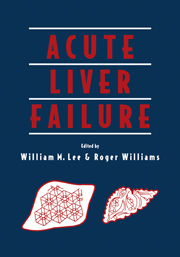Book contents
- Frontmatter
- Contents
- Preface
- Foreword
- Acknowledgments
- Contributors
- Part One Clinical Syndrome and Etiology
- Part Two Mechanisms of Disease and Multisystem Involvement
- Part Three Intensive Care Management
- Part Four Transplantation
- Part Five Artificial and Bioartificial Liver Devices
- 18 Extracorporeal liver support: historical background and critical analysis
- 19 Hepatocyte culture and bioreactor design for liver support systems
- 20 Clinical experience with an extracorporeal liver assist device
- Part Six Other Applications
- Index
- Plate section
20 - Clinical experience with an extracorporeal liver assist device
from Part Five - Artificial and Bioartificial Liver Devices
Published online by Cambridge University Press: 20 May 2010
- Frontmatter
- Contents
- Preface
- Foreword
- Acknowledgments
- Contributors
- Part One Clinical Syndrome and Etiology
- Part Two Mechanisms of Disease and Multisystem Involvement
- Part Three Intensive Care Management
- Part Four Transplantation
- Part Five Artificial and Bioartificial Liver Devices
- 18 Extracorporeal liver support: historical background and critical analysis
- 19 Hepatocyte culture and bioreactor design for liver support systems
- 20 Clinical experience with an extracorporeal liver assist device
- Part Six Other Applications
- Index
- Plate section
Summary
INTRODUCTION
Acute liver failure (ALF) results in failure of the body to sustain vital metabolic functions such as energy production, protein synthesis, and detoxification–excretion of metabolic by products. In addition, experimental evidence suggests that plasma from patients with ALF is cytotoxic (Seda et al. 1984a), possibly as the result of cytokine and free radical release from the necrotic liver (Nagaki et al. 1991). This combination of decreased metabolic reserve and increased levels of cytotoxic compounds determines the severity of the clinical syndrome which follows.
Development of liver support has been ongoing for at least 30 years, and has included techniques such as hemodialysis, blood and plasma exchange, xenogeneic and allogeneic liver perfusion, and blood “purification” with charcoal and ion exchange resins (Sussman and Kelly, 1995a and Chapters 18 to 21). Despite a number of promising preliminary reports with various techniques, the results of clinical studies in man have been disappointing, that is, no mode of treatment appears to improve survival after ALF. Although non-biological systems such as charcoal hemo-perfusion are capable of reducing levels of ammonia (Schechter et al. 1984), “middle molecules” (Opolon 1979) and other putative deleterious compounds (Seda 1984b; Nagaki et al. 1991), these systems do not provide the requisite metabolic support to sustain a patient with ALF until regeneration of the native liver can occur.
Extracorporeal perfusion of a whole liver theoretically provides a complete form of organ replacement.
- Type
- Chapter
- Information
- Acute Liver Failure , pp. 255 - 266Publisher: Cambridge University PressPrint publication year: 1996



